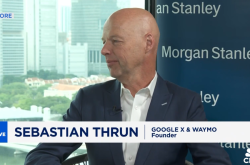One-week AI Highlights | Alibaba and Ant Group Make a Big Push for AI Assistants; Industry Experts Claim Gemini 3 Pro Falls Short of Being a Generational Leader
![]() 11/24 2025
11/24 2025
![]() 549
549
Last week, the AI assistant landscape was abuzz with activity. Overseas, Google's Gemini 3 Pro stole the spotlight, but industry insiders argue that this model hasn't quite achieved generational-level dominance.
01. Alibaba and Ant Group Step Up Their Game in the AI Personal Assistant Market
On November 17, Alibaba officially rolled out the public beta of the QianWen APP. This personal assistant product is clearly aimed at taking on ChatGPT, featuring Alibaba's most advanced Qwen3-Max model. It's positioned as the go-to gateway for Alibaba's AI-native applications aimed at consumers.
Previously, Alibaba's dialogue assistant offerings, TongYi and the Quark Personal Assistant within the Quark APP, were brought together under the "QianWen" brand. From an outsider's view, Alibaba Group's personal assistant apps now seem to be consolidating their efforts.
This move is in line with Alibaba's strategic push into AI for consumers (AI ToC) over the past year. In December of the previous year, Alibaba shifted the product team behind its AI app "TongYi" from Alibaba Cloud Intelligence to the Intelligent Information Business Group. After this reshuffle, the TongYi App and Quark became peers under the AI ToC umbrella, both overseen by Wu Jia.
On January 15 this year, Quark updated its brand tagline to "The AI All-Round Assistant for 200 Million People." Shortly after, media reports indicated that the Tmall Genie team had officially merged with the Quark product team. The combined team is set to explore new hardware avenues, including AI glasses.
On March 13, the new Quark was officially launched, integrating features like AI dialogue, deep thinking, execution, search, cloud storage, and writing to create an "All in One" AI super-platform. Late last month, Quark got another upgrade, introducing an "AI Dialogue Assistant" mode.
The battle in the AI-native application space kicked off last year. In the first half of the year, Doubao and KIMI went head-to-head in a talent war on social media. Early this year, DeepSeek took the mainstream market by surprise, leading to a significant surge in user numbers. Soon after, Yuanbao jumped into the fray. According to Questmobile data, in the third quarter of 2025, Doubao's monthly active users hit 172 million, surpassing DeepSeek's 145 million, with Yuanbao coming in third.
Why did Alibaba choose to merge its AI ToC capabilities into QianWen at this juncture? The QianWen team mentioned in a LatePost interview that, currently, no domestic AI app has broken the 100 million DAU (Daily Active Users) barrier as a national-level app, making QianWen's entry well-timed. Additionally, the QianWen team stated that a significant part of their next phase involves collaborating with various Alibaba businesses, including AutoNavi, Taobao, Alipay, and Ele.me.
With the transition of Quark's original AI dialogue assistant to "QianWen," the roles of Quark and QianWen have become clearer. Quark is positioned as an AI search and AI browser, while QianWen is focused on building the AI dialogue assistant, a product form that's currently getting a lot of public attention.
Just a day after QianWen's launch, Ant Group officially introduced "LingGuang," a "full-modal general AI assistant," also making strides in the personal assistant arena.
LingGuang is directly overseen by Ant Group's CTO, He Zhengyu, with Cai Wei leading the LingGuang APP team. The project kicked off in March this year with a team of 200. Ant Group's CTO also mentioned that LingGuang initially aimed for 200,000 users by year-end but hit that target on its very first day. Jack Ma expressed his hope for LingGuang to "aim for the top spot."
According to Ant Group, LingGuang is the first AI assistant capable of full-code generation for multimodal content, supporting information output across various formats like 3D digital models, audio, icons, animations, and maps. It enables "everyone to create apps by hand," surpassing 1 million downloads within four days of launch.
Currently, besides LingGuang, the Ant ecosystem includes two vertical AI application products: the AQ medical assistant and the Ma Xiaocai financial assistant. Earlier this month, Ant Group also underwent an organizational restructuring, establishing a Medical and Health Business Group to intensify its focus on the AI medical and health sector.
These moves signal that Alibaba and Ant Group are taking a more aggressive stance and ramping up investment in next-generation consumer-facing products and applications in the AGI era. The domestic AI application sector might be entering a new competitive phase.
02. Industry Veterans Weigh In: Gemini 3 Pro Doesn't Quite Hit the Mark
Last week, Google's release of Gemini 3 Pro sparked widespread discussion. The most notable aspect was that, amidst numerous evaluation systems for large models, except for SWE bench (Software Development Engineering), where Claude Sonnet 4.5 still leads, Gemini 3 Pro dominated nearly all other evaluations.
However, a seasoned AI programming team in China told Shuzhi Qianxian that they believe Gemini 3 Pro hasn't quite achieved a "generational" leap, leading by roughly 0.3 to 0.5 generations.
Regarding concerns that a large number of programmers might be replaced, the team believes that, currently, Gemini 3 Pro's overall code generation complexity is still lacking, requiring significant human input. Thus, AI programming is still in the "human-machine coexistence" stage.
After using Gemini 3 Pro, the team found it superior to Claude 4.5, GPT-5.1, and Grok 4.1 in front-end programming capabilities. Previously, the front-end code generated by these models was relatively basic, whereas Gemini 3 Pro's code shows a certain level of complexity, with front-end page effects and animation visuals scoring close to 8 out of 10. In generating an App's front-end page, Gemini 3 Pro outperformed Claude 4.5 and GLM 4.6 in terms of detail and code complexity.
However, the team pointed out that Gemini 3 Pro's back-end logic is still inadequate, primarily focusing on single-page or multiple single-page structures without breaking through more complex back-end architectures. Nevertheless, this represents a significant step forward in front-end development, surpassing the leader, Claude, by at least half a generation—a notable breakthrough.
Programming generally divides into front-end and back-end. Front-end development involves user-facing interfaces and interactions, translating product visuals and operational logic into directly experienceable page elements, such as button clicks, page transitions, and style presentations. Back-end development supports product operations with data and logic, handling backend functions like user login verification, data querying and modification, and server scheduling.
03. Huang Chenhong, Former SAP Greater China President, Takes on a New Challenge
Dr. Huang Chenhong, former Chairman and President of Dell Greater China and President of SAP Greater China, has taken on a new role. It was officially announced that he will serve as the Chairman of the Board, Executive Director, and CEO of SuperX starting December 1.
According to reports, SuperX is headquartered in Singapore, tracing its roots back to a Hong Kong-based interior design company that later evolved into Junee Limited, which went public on NASDAQ in April 2024. In June 2025, the company rebranded as SuperX AI Technology Limited, officially transitioning into an AI infrastructure solutions provider and began trading under the new ticker "SUPX" that month.
Since its transformation, SuperX has been making frequent moves in recent months, appointing core technical executives and establishing joint ventures with enterprises like Hengtong Electric and Chengtian Weiye to invest in liquid cooling and high-voltage DC power supply sectors. Simultaneously, it is advancing the construction of an AI supply center in Japan and established a wholly-owned subsidiary in the United States in September to build a global business framework.
Currently, SuperX's main products cover AI servers, power supply equipment, and modular AI factories, catering to scenarios like AI large model training and data center construction. This resembles Dr. Huang's previous business at Dell.
After leaving Dell, Dr. Huang served as SAP's Global Executive Vice President and President of Greater China. In 2025, he briefly joined Yonyou Network, sparking widespread attention and industry discussions on short-term performance pressures, long-term strategic planning, reform adaptability, and corporate governance.
04. Embodied Robot Shipments Set to Exceed 10,000 Units Industry-Wide This Year
Recently, at the 2025 Embodied Intelligence Open Day hosted by the Zhiyuan Institute, senior figures from over 30 companies across various segments of the embodied intelligence industry chain, including Galaxy General, Zhiyuan, Xinghaitu, and Beijing Humanoid, shared several key insights:
First, the technological roadmap for embodied intelligence hasn't yet converged, but the ultimate state will trend toward a unified architecture. Multiple industry insiders pointed out that, unlike the question-and-answer open-loop model of large language models, future embodied intelligence foundation models will be dynamic closed-loop systems featuring "actions - world feedback - real-time adjustments."
Second, 2025 marks a year of accelerated progress for embodied intelligence in various senses, characterized by "resource absorption, technological emergence, and mass production."
Yao Maoqing, Partner and President of the Embodied Business Unit at Zhiyuan Robotics, stated on-site that embodied intelligence is continuously absorbing core resources from various industries across capital, talent, and other dimensions, becoming a key sector for resource aggregation.
This trend is particularly evident in the recent flurry of financing activities. Data shows that in October, 33 financing events were disclosed in the embodied intelligence robot and core technology sectors. Among them, Leju Robotics topped the "fundraising" chart with a near 1.5 billion yuan Pre-IPO round. Since November, companies like Wujie Dongli, Qiaojie Shuwu, Yuanli Lingji, Xingdong Jiyuan, and Xingchen Intelligence have also completed new financing rounds, with capital enthusiasm continuing to rise.
2025 is also widely recognized as the first year of mass production in the industry. Leading embodied robot manufacturers have shipped between 1,000 to several thousand units this year. Cai Yingpeng, Founder and CEO of InTime Robotics, revealed that industry-wide shipments of robot bodies and dexterous hand products are expected to exceed 10,000 units this year, surpassing the cumulative total of the past decade and marking a significant industry milestone.
Some viewpoints suggest that current shipment volumes of embodied robots still don't quite match their high market valuations. However, multiple industry figures admitted that their greater significance lies in enabling robots to enter real-world scenarios as much as possible, acquiring high-quality data in these environments, and gradually initiating the data flywheel effect.
Third, embodied intelligence has seen pilot deployments in some scenarios, but true "killer applications" have yet to emerge. The industry anticipates large-scale deployments of humanoid robots in some vertical sectors next year.
For example, Pu Tianjiao, Deputy Chief Engineer of the China Electric Power Research Institute and Director of its Artificial Intelligence Research Institute, revealed that they have collaborated with Beijing Humanoid and Unitree to deploy embodied robots in scenarios like substation switch operations and live-line work on distribution lines. Pilot applications in some regions have achieved 90% accuracy, significantly enhancing autonomy compared to traditional fixed-path robots. Yu Rongrong, General Manager of China Mobile's Smart Home Center, stated that China Mobile has piloted consumer-grade robotic dogs in 16 cities for home use. Currently, emotional value accounts for 70-80% of the product delivery experience, with functional value at 20-30%. They anticipate that after breakthroughs in haptic technology next year, functional value will rise to 50-60%.
Industry insiders told Shuzhi Qianxian that current embodied robot deployments primarily focus on two scenarios:
1. Human-machine interaction-oriented scenarios like education, exhibition hall explanation and reception, and museum tour guidance. These areas currently see higher shipment volumes and relatively stable deployment performance.
2. Factory scenarios, which still face numerous challenges. For instance, some practitioners mentioned that robots require recharging every 1-2 hours, making it difficult to match the continuous operation demands of factories. Li Kai, Chief Expert in Embodied Intelligence at China Unicom, shared a failed case study. In a bearing factory, if AI detection rates do not reach 98%, they cannot replace veteran workers. Even if this threshold is met, two major bottlenecks persist: robots' speed, limited by computational power, falls far short of human output rates, and equipment is prone to failures, with any downtime causing full-line production halts.
Wang Zhongyuan, President of the Zhiyuan Institute, admitted that while humanoid robots have made significant progress from "walking" last year to "running" this year, the industry is still in its early stages. For instance, in terms of hardware stability, his team encountered issues with 5 out of 10 purchased robots malfunctioning within one to two months, directly constraining their deployment in genuine industrial and home scenarios.
He judged that with continuous technological iterations and optimizations, industrial scenario deployments will progress relatively faster, while home scenario deployments will take longer, with humanoid robots entering households in at least five to ten years.
05. The Momentum for AI Glasses Continues to Surge
This week will witness the official launch of Quark AI Glasses, which signifies Alibaba's inaugural venture into the realm of AI glasses equipped with binocular displays. These glasses are priced at 3,999 yuan for the general public, while 88VIP members can enjoy a discounted rate of approximately 3,299 yuan. Notably, Baidu's Xiaodu AI Glasses and Rokid's AI Glasses made their debut on the same day not long ago.
Judging by the sales of products currently on the market, non-display AI glasses typically retail for around 2,000 yuan. In contrast, AI glasses incorporating light waveguide displays usually command a price point in the vicinity of 3,000 yuan.
Furthermore, Xiaomi's AI Glasses, which have been available for five months, recently underwent a software update. This update has endowed the glasses with the ability to function as English-speaking practice partners and to enable voice control for Xiaomi cars.
As the most sought-after AI hardware at present, the successive launches of AI glasses have spurred a swift surge in sales. Data from the Department of Electronic Commerce of the Ministry of Commerce reveals that online retail sales of smart wearable devices, such as AI glasses and smartwatches, have experienced a 23.1% increase over the past ten months. Zhu Mingming, the founder of Rokid, predicts that Rokid's shipment volume will surpass one million units in the coming year.
In addition to the surge in sales, capital is also flowing into this sector with great enthusiasm. Raybo Innovation declared the completion of its Series C financing in November. Although the official funding amount remains undisclosed, the company asserts that it has established the highest single-round financing record in China's domestic AI+AR glasses sector for 2025. Industry insiders speculate that Raybo Innovation's total Series C financing might have reached 800 million yuan. In September, VITURE successfully secured two additional Series B financing rounds, totaling $100 million. Meanwhile, INMO Technology obtained over 150 million yuan in Series B2 financing in July.







